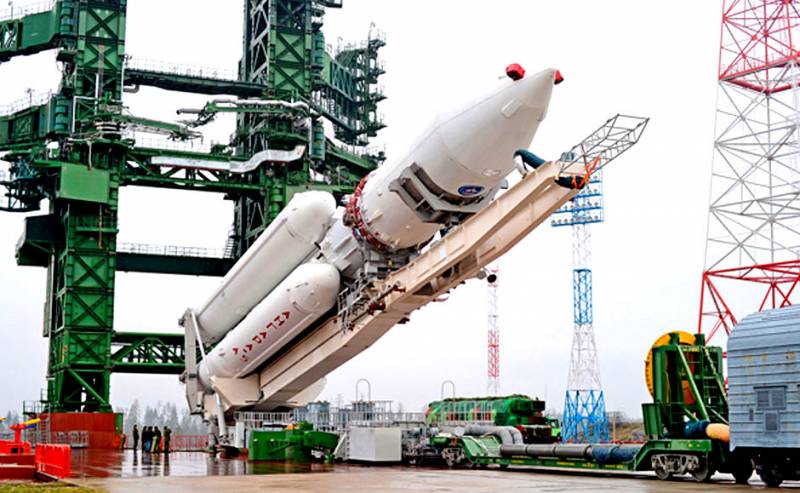Russian "Angara" is gaining speed
The collapse of the USSR was a heavy blow to the domestic space industry. Many enterprises and specialists of the once united production chain suddenly found themselves cut off by the state borders of Ukraine, Belarus and Armenia. Even the legendary Soviet Baikonur cosmodrome remained in neighboring Kazakhstan. In the nineties, domestic astronautics fell into decline without adequate funding that could help solve these problems.
In the "obese two thousandths" of the Russian space industry was more fortunate. It was decided to invest part of the petrodollar revenues in the development of Russian space. Work began on the construction of a new domestic space center Vostochny. And the Khrunichev Center developed from scratch a new-generation Angara rocket for launches from Vostochny and Plesetsk. During the development of the Hangar, the past problems and mistakes were taken into account:
1. The missile was created exclusively in the framework of industrial cooperation within the Russian Federation.
2. The modular design allows you to create a whole family of launch vehicles from light to the heaviest class. Also, modularity simplified the transportation of the product to the launch site.
3. The decision is correct to replace toxic heptyl as fuel of the launch vehicle with safe kerosene and oxygen.
The resulting Angara rocket can completely replace the need for Proton launches from Baikonur, which is being rented from Kazakhstan. Over time, a complete transition to the Russian cosmodromes Plesetsk and Vostochny is possible.
The Angara missile is completely the brainchild of the young Russian Federation, and it is forced to join the race with the American hawk, Ilon Mask. The billionaire’s ambitious plans to launch thousands of new satellites into the Earth’s orbit to provide an ultrafast Internet signal, the plans for the exploration of distant Mars, cannot force Russia to remain outside the space race. Also of great concern to the Russian leadership is the extravagant plans of the US military to militarize the near-Earth space and the surface of the moon.
These challenges require an adequate response from the Russian side. Vice Prime Minister Dmitry Rogozin, who visited the branch of the State Research and Production Space Center named after MV Khrunichev PO Polet, outlines his requirements for launch vehicle manufacturers.
- quoted by the Deputy Prime Minister RIA News.
Rogozin emphasized that in Roskosmos so far they plan to make the “light” Angara 2019 and Angara 1.1 missiles in 1.2, while the heavy version, according to the original plan, was due to appear by 2022.
In the "obese two thousandths" of the Russian space industry was more fortunate. It was decided to invest part of the petrodollar revenues in the development of Russian space. Work began on the construction of a new domestic space center Vostochny. And the Khrunichev Center developed from scratch a new-generation Angara rocket for launches from Vostochny and Plesetsk. During the development of the Hangar, the past problems and mistakes were taken into account:
1. The missile was created exclusively in the framework of industrial cooperation within the Russian Federation.
2. The modular design allows you to create a whole family of launch vehicles from light to the heaviest class. Also, modularity simplified the transportation of the product to the launch site.
3. The decision is correct to replace toxic heptyl as fuel of the launch vehicle with safe kerosene and oxygen.
The resulting Angara rocket can completely replace the need for Proton launches from Baikonur, which is being rented from Kazakhstan. Over time, a complete transition to the Russian cosmodromes Plesetsk and Vostochny is possible.
The Angara missile is completely the brainchild of the young Russian Federation, and it is forced to join the race with the American hawk, Ilon Mask. The billionaire’s ambitious plans to launch thousands of new satellites into the Earth’s orbit to provide an ultrafast Internet signal, the plans for the exploration of distant Mars, cannot force Russia to remain outside the space race. Also of great concern to the Russian leadership is the extravagant plans of the US military to militarize the near-Earth space and the surface of the moon.
These challenges require an adequate response from the Russian side. Vice Prime Minister Dmitry Rogozin, who visited the branch of the State Research and Production Space Center named after MV Khrunichev PO Polet, outlines his requirements for launch vehicle manufacturers.
The task is that not in 2022, but at least in 2021, we could already begin mass production of the Angara
- quoted by the Deputy Prime Minister RIA News.
Rogozin emphasized that in Roskosmos so far they plan to make the “light” Angara 2019 and Angara 1.1 missiles in 1.2, while the heavy version, according to the original plan, was due to appear by 2022.

Information